For a time I was looking into getting a product from Thalmic, now known as North or maybe some other sort of body hack that would allow for me to extend my sensory perception. A magnet in my finger to guide my directions and pick up screws or some monitor hooked into my vitals --something hella cyberpunk. I'm still interested in pursuing something of the sort (despite fear of demagnetizing something on accident), but my long-running and increasingly acute experience with phantom vibration has given me some pause.
Phantom vibration syndrome is defined along the lines of "perceived vibrations from a device that is not really vibrating [1]. Essentially, since the age of pagers, humans have begun to mentally connect the pulse of a certain frequency with a particular ringing device. In some cases the source of the illusion may be a spot on the body where the device usually rests (a wrist or a pocket), but in others (such as for myself) the sound may also be associated with a region in the room where the device usually or actually resides. It can occur when a similar frequency is generated by a television commercial, a song on the radio, or in my case, the plumbing of my apartment. In 2005 Brenda Goodman reported "the ear gives unequal weights to certain frequencies, making it particularly sensitive to sounds in the range of 1,000 to 6,000 hertz"[2]. Her article in particular piqued my interest in this auditory quirk. Why was I hearing my phone start buzzing on the endtable when there was no phone call?
The research into phantom vibration syndrome is rather sparse and anecdotal [1] [3][4][5] (no diss to the field of pyschology intended) and generally looks at the clinical occupation as a case study. Comparisons of the symptoms of phantom vibration syndrome reveal a mild relation to those of PTSD and the recently widowed. It often appears with neuroticism [4] and occupational (or emotional) burnout [5]. It's certainly a rather trivial condition compared to the multitude of other psychological disorders in the world. Momentary distractions and the eeriness that follows are not particularly disruptive unless combined with more systematic anxiety or paranoia. Simple steps, such as switching phones, switching pockets, or (less simply) switching jobs can make the hallucinations go away. But, as humans as a society become more interconnected with wearable devices and the emotional implications that notifications bring, I believe the condition is ripe for exploration. And I'm a great guinea pig!
I'm not someone unfamiliar with hallucinations and I've noticed that I'm particularly prone to auditory manifestations. My ears are pretty sensitive (though my ability to sleep through alarms begs to differ). My handling of unwanted, persistent, loud noises could probably be classified on the autism spectrum. That being said, I went to hardcore punk and harsh noise shows growing up without much issue aside from possible hearing loss (worth it). In the case of phantom vibration syndrome, I've had mild cases of it since I got my first cell phone in 2008. Hormonal anxiety mixed with a familiar vibration in my pocket lead to frequently opening my Nokia flip-phone to an empty inbox despite swearing I had felt that sensation. I was quite the popular kid as you can tell. But my experience didn't end when those relationships with girlfriends expecting immediate responses to all messages fell apart (go figure). It has continued and intensified in my professional life.
As I may have mentioned in previous blog posts, I have been at the time of this post a platform engineer for a little over a year and had been an application operations intern for a few years before that. I've had varying degrees of responsibility for managing a 24/7 production server environment during most of that time which translates to an on-call rotation. For those unfamiliar, on-call workers are responsible to respond to pagers (read: texts/phone calls) at any point in any day. These alerts can be send out by automated monitoring systems (shout out to the purple canine) or by coworkers or customers in need. On-call schedules vary by organization [PDF] but generally have one person as the first line of defense and a second person that is called if the first doesn't respond in time or needs help. Presently, my rotation is a week long and rotates between four people. 1/4 of my time I'm the on-call, 1/4 of the time I'm the secondary, and 1/2 of the time I'm still compulsively checking our automated monitoring alerts channel because Slack is an attention demon and I like to feed it. But obviously, by my continuation in the field, I love the work. It's a lot more than putting out fires and fixing bugs.
The on-call rotation is, however, one of those duties that everyone dreads. It doesn't take holidays off. The internet doesn't sleep. But because on-call is necessary and critical to the success of the organization, it has an aura of chivalrous machismo attached to it. Rah! Charging into the snares of global routing issues at 2am, a hero of the people, right? It certainly does provide for a wonderful sense of worth and helps with the imposter syndrome that is so easy to come by as a young engineer.
But obviously, a repeated on-call rotation, or an especially difficult one, can be traumatic or ruin an important night's sleep to say the least. I've had troubled weeks where I would sleep on the living room futon, one arm on the laptop in case of an emergency and far enough away from my girlfriend that at least she could get some rest before work. The pager is a time-critical system. A given alert could be the whole site being down or just a temporary load spike in an unimportant subsystem. Mandatory plug for observability. Checking on the alert bubbles up to priority number one for your brain's homunculus. I've been in the middle of transactions, meals, hikes, bike rides, turnstiles, parades, wet dreams, and gotten that familiar buzz in my pocket. There's that bottom-of-the-stomach sensation until you actually read the context of the alert and it either goes away or you whip out your laptop (I swear my girlfriend has a secret stash of pictures of me in jammie pants, sweating in the Flux light of a screen). And it sucks, but it's expected. The ghost pager calls aren't expected.

|
| Scammers can't leave messages with all these voicemails. |

|
| When you forget to tune your alerts before you go on-call |
My phone is a OnePlus 3T. It has a very... distinct vibration. It's honestly louder than the ringtone itself. When I receive a page, I receive it as a text. Buzz-Buzz. Then, as a phone call. Buuuuuuuuuzz-pause-Buuuuuuuuuzz. At which point I'm already centimeters from my phone screen, wiping eye-gunk on my password unlock to read the alert from the PagerDuty app. I'm pretty quick. I haven't missed a page in months. But this psychological conditioning has had side effects with the normal use of my phone. Any and all text messages make the same noise. When my best friend wants to wake me up at 8am (11am his time) to play Foxhole (ironically, he has an on-call rotation for a chemical plant) or when T-Mobile wants to send me my cell phone bill invoice at 4am, I'm jolted awake. More painfully, when I type my lockscreen password incorrect, I'm rewarded with the same extended vibration as a phone call. Mixing the initial phone call with sleepily mistyping my password has nearly gotten me kicked out of my apartment.
Thus, out of that hair-trigger notice during my week-long stints of on-call, I get occasional phantom vibrations. When I'm biking to work, my phone rubbing in my pocket triggers the sensation. On my patio, the sound of certain probably-illegally-modified cars passing on I-580 trigger it. In my bed, on some nights, the sound of the plumbing in my mid-century apartment building will trigger it. Relief is instantly gained when I see there is no real issue, but it is certainly distracting from whatever reading, sleeping, orr biking I was doing. I suppose it's as if I had notifications on for all of the dumb Nextdoor threads that occur and the notification was the same as the one I expected to receive from a long-lost friend. There's an adrenaline rush and core memory dump that takes place in my brain before I even look to see that my phone's notifications bar is blissfully clear or my pocket was empty the whole time. What the hell was I even doing before the buzz?
Despite my familiarity with a group of engineers focused on observability and humanizing server operations, I haven't heard widespread discussion of phantom vibration syndrome as a consequence of their work. On-call isn't really a sexy subject to begin with, more of the butt of jokes for the firefighters to make. And given the variety of ways people have alerts configured on their devices, it may not be a widespread issue like it has been with pagers in hospitals. When I did begin asking around, many people have reported experiencing phantom vibration syndrome just from everyday smartphone use. It was reported to be mild and infrequent. The connection between the noise/tactile sensation and the mental conception of a notification would make sense to vary by phone and depend on the emotional attachment to a given notification, right? Then what about this phone in particular is driving me nuts?
Experiment time! I decided to see what frequency my phone, the aforementioned OnePlus 3T was vibrating at and then compare it with the other phone that I had on hand-- my reluctant girlfriend's iPhone 8. In order to test the noise that my phone makes in various locations in my apartment, I recorded the various default vibrations of both the iPhone and the OnePlus: in an airgapped setting-- the endtable near my bed, on another electronic device (I often have my phone on my laptop because I'm a dirty millenial or whatever), and against my leg in my pocket.
Process
- I recorded each device in the bedroom of my apartment with the built-in microphone on my
laptop. (high-tech, I know). This was recorded in Audacity. I measured:
- Ambient sound (Ambient)
- Default vibration at a distance of about fifteen cm from the mic (Air-gapped)
- Default vibration against the laptop at about fifteen cm from the mic (Adjacent)
- Default vibration against my thigh which was also touching the laptop at about fifteen cm from the mic (Pocket)
- I saved each recording snippet and used Audacity's Frequency Analysis (Analyze > Plot Spectrum) on sections of the audio that were entirely the vibration tone. The spectrum displays essentially the whole spectrum of human hearing ~20hz to 20khz [6]. They end up looking something like (fig 1) below this list. This is the airgapped iPhone vibration.
- I exported the data using Audacity's Export function within the Frequency Analysis window and aligned the data in a spreadsheet program
- After normalizing each recording against the ambient data in a very naive way (subtraction ftw) I plotted this data with a logarithmic X-axis as to resemble that of Audacity's native representation. (fig 2)
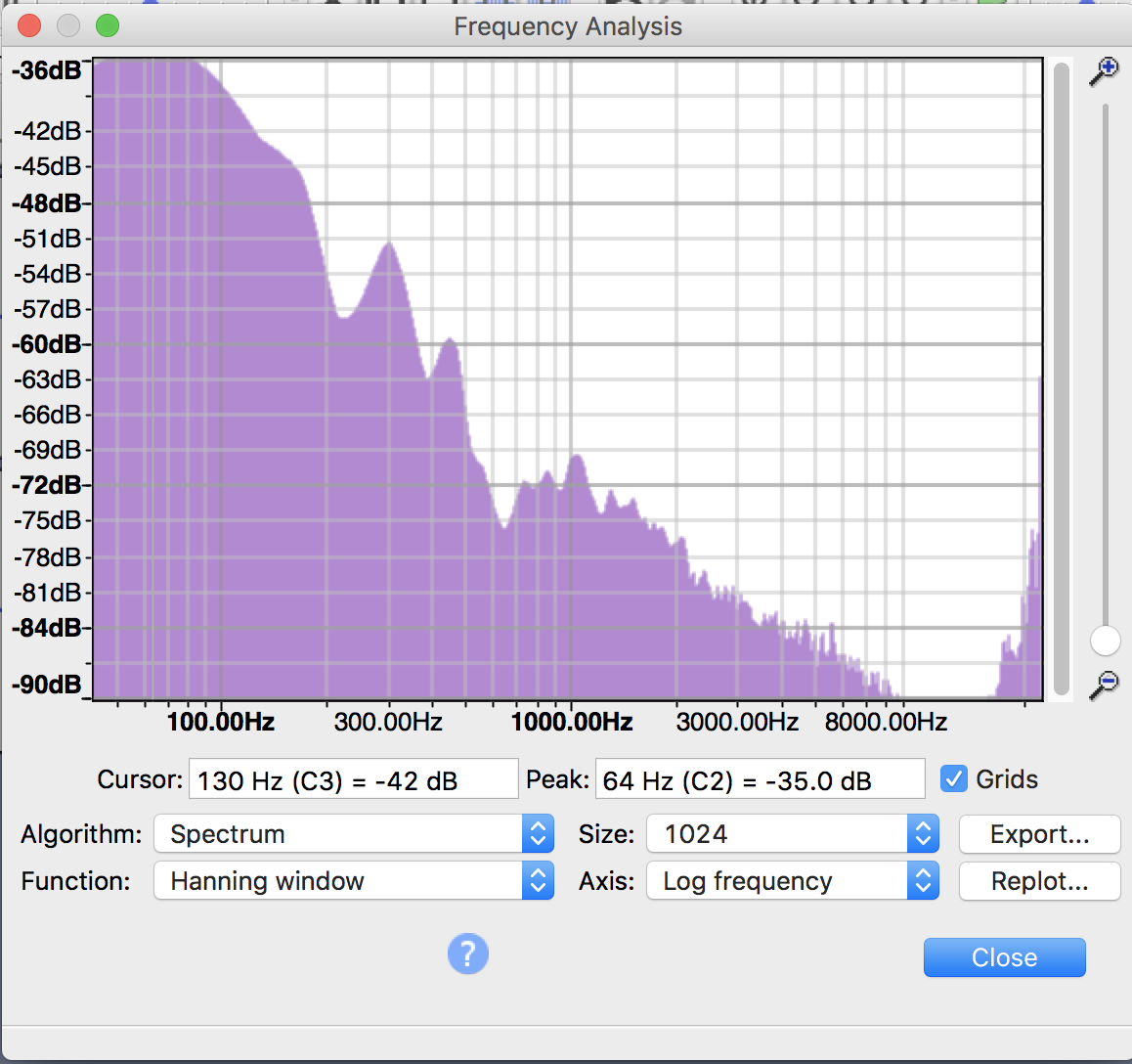
Fig. 1

|
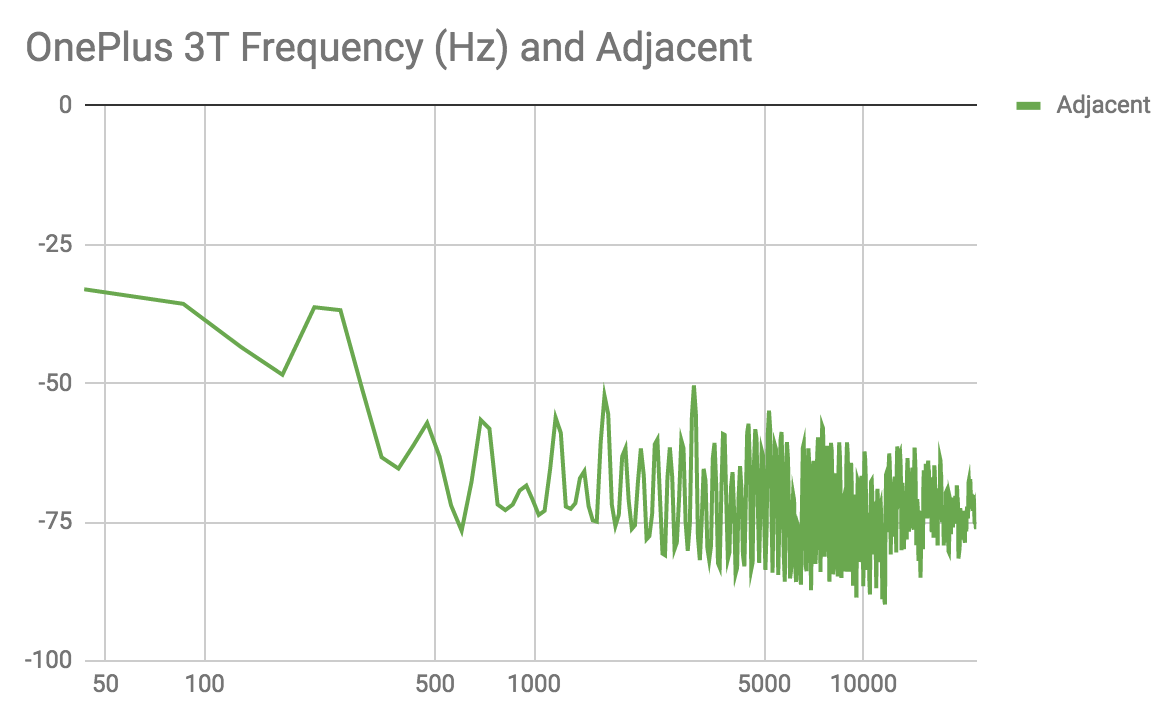
|
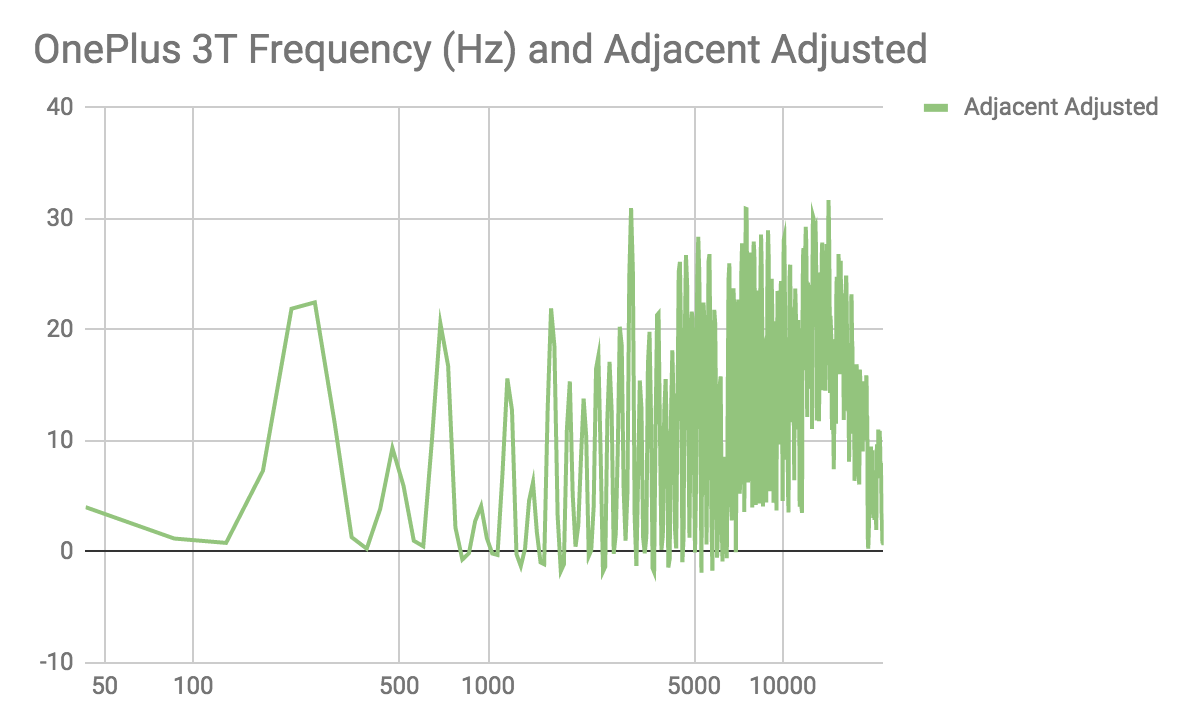
|
| Ambient Sample | Sample Containing Vibration on Laptop | Sample Containing Vibration on Laptop Normalized |
Fig. 3
The following table contains the data as well as spectrum samples that I obtained through my amateurish experimentation.
| OnePlus 3T | iPhone 8 |
|---|---|
| Spectrum Analysis Data | |
| CSV | CSV |
| Ambient Sample | |

|
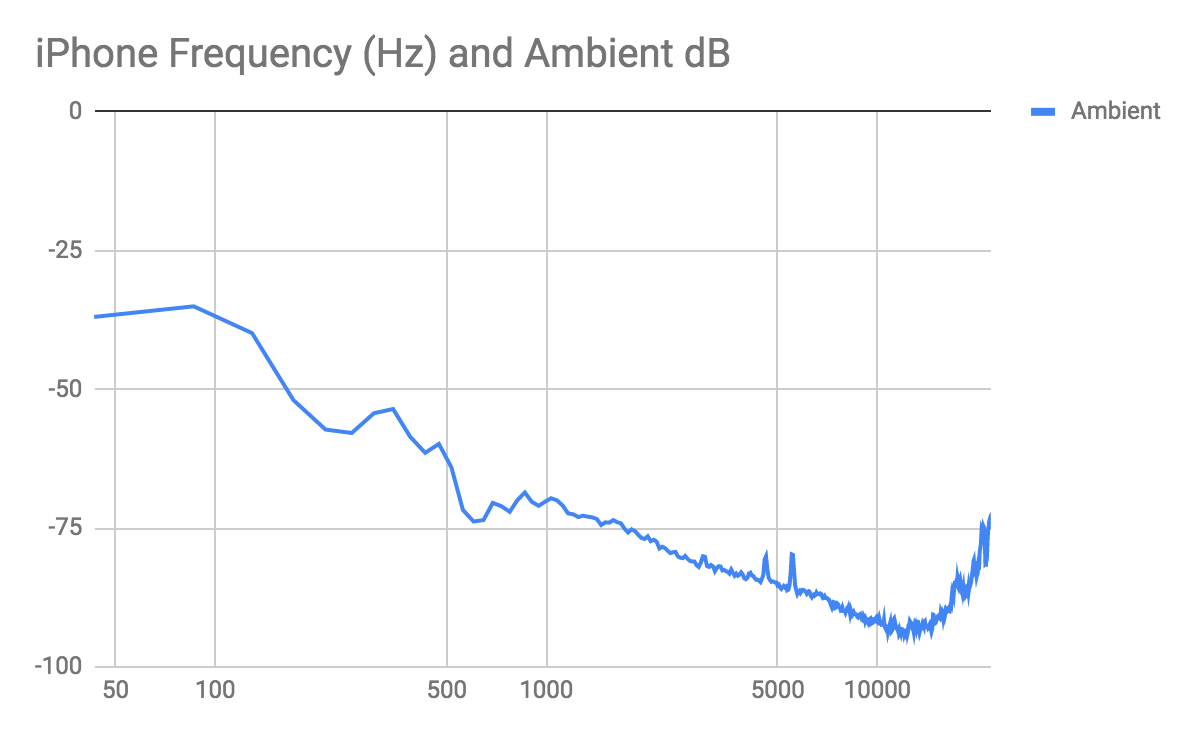
|
| Air-gapped Sample (Normalized) | |
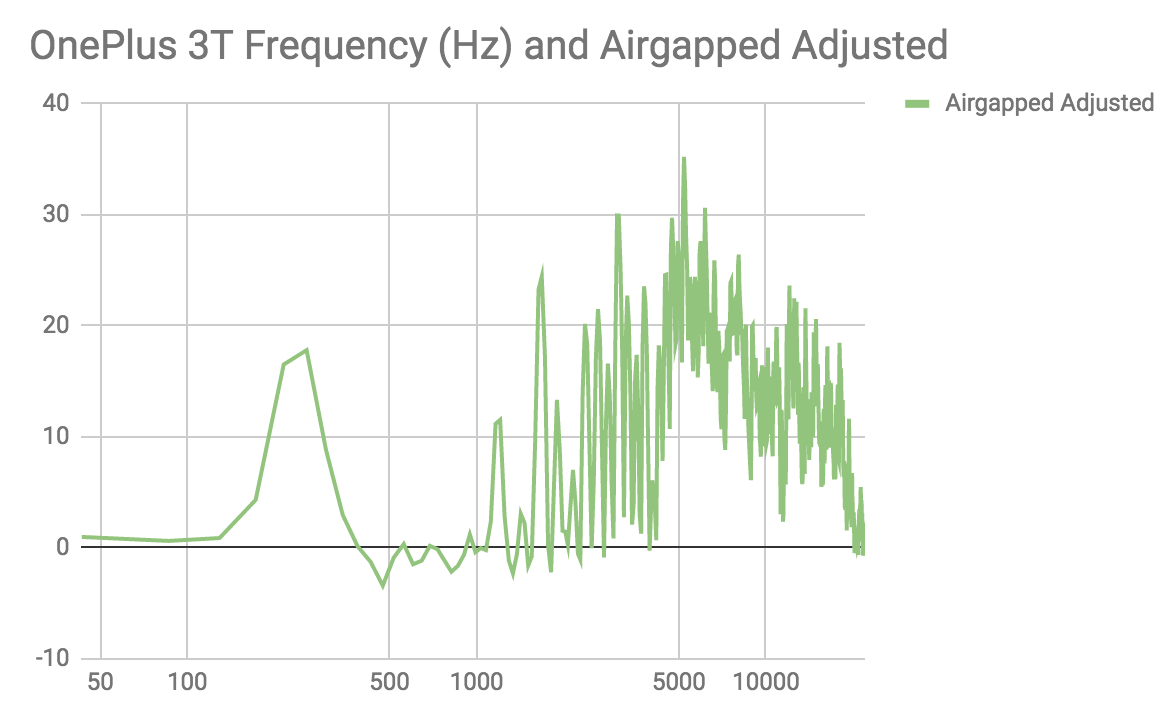
|
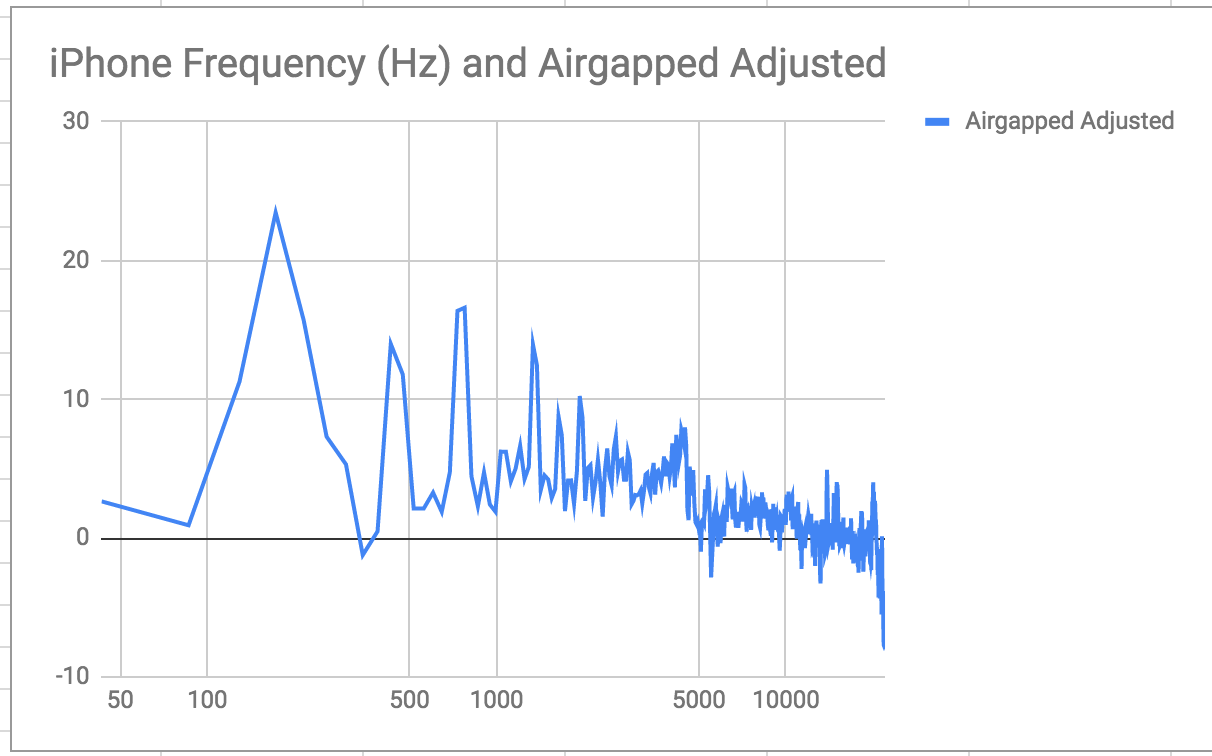
|
| Laptop-Adjacent Sample (Normalized) | |

|

|
| Pocket Sample (Normalized) | |
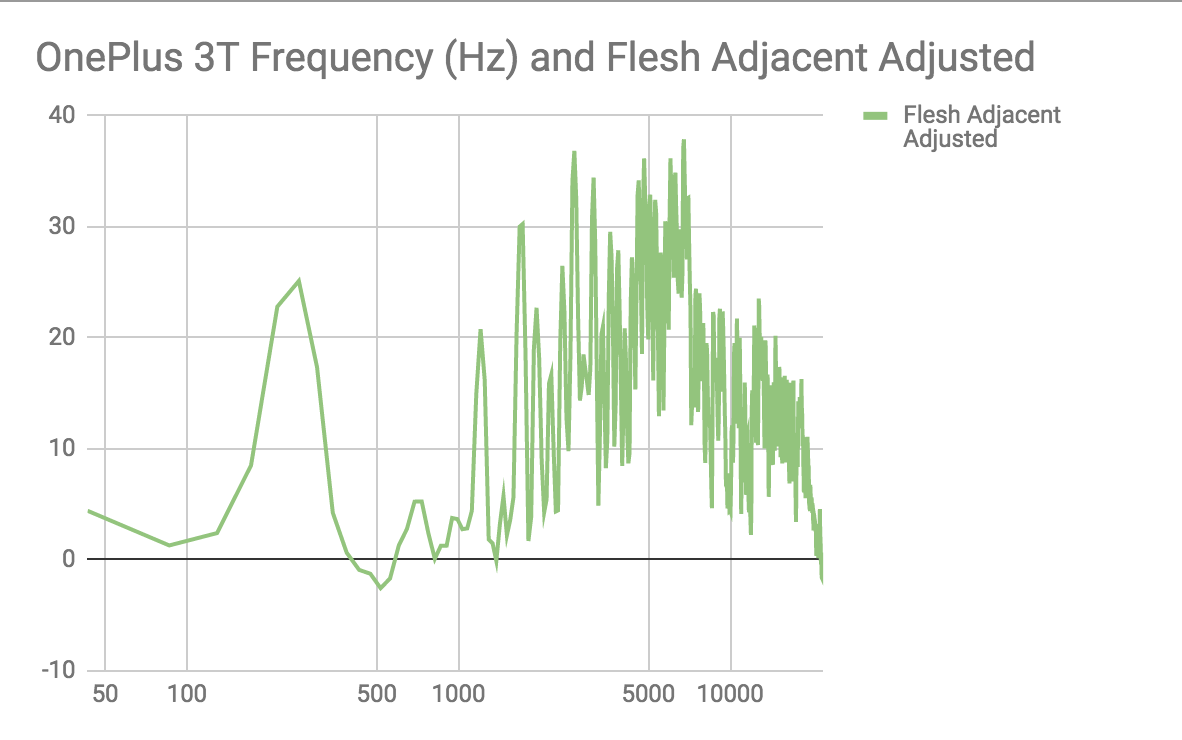
|
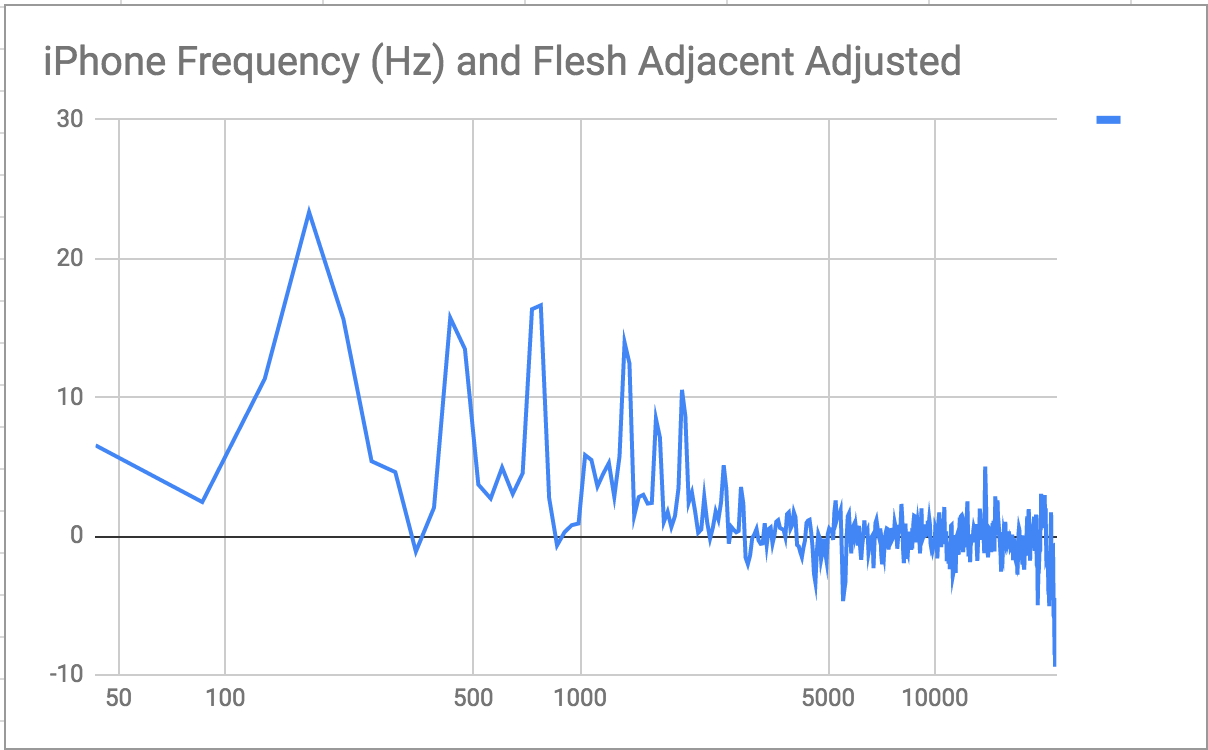
|
Both the Pocket and the Air-Gapped sample peak around 5000hz, within the higher end of the range that Goodman reported as being the driver of phantom vibration syndrome[2]. These samples were also taken in locations I generally have the most recollections of hallucinations. The tactile memory of the pocket and the often liminal states of consciousness I experience when my phone is on my endtable probably maximize this phenomenon.
The iPhone's vibration is substantially quieter! It has certainly woken me up in the past, but it's almost inaudible when on my endtable.
It makes sense that the simulations of phone-on-laptop rendered a higher frequency sound wave given that the contact surfaces are (sorta) metal versus the muted contact surface of phone/wood or phone/fleshy pants.
- This experiment doesn't dig into the half of the hallucination that I find the most unsettling and disruptive-- the tactile element. I would love to experiment with ways to simulate a vibration-- perhaps playing back certain frequencies and self-reporting any hallucination. Given that phantom vibration syndrome is almost certainly driven from the sub-conscious, this would probably be challenging. Utilizing a dream-state or low-dose psychedelic drugs would be a challenging, but possibly fruitful avenue to explore. Maybe even a certain pair of jeans really makes me think I need to hop off my bike to check server metrics.
- This experiment was mostly a thought experiment and doesn't consider itself too regimented. There is no high-tech equipment involved. The scenarios are based off of anecdotes remembered by the designer. No other anecdotes were incorporated into this initial experiment. I didn't try any radio programs or annoying commercials to trigger the buzzing sensation.
- I need feedback and input! I only cast out a small net of inquiry to the humans familiar to me regarding this phenomenon. I'm sure I could get some interesting and novel information about the prevalence of phantom ringing in people other than Instagram-addicted tweens and medical interns if I do as the psychology academics and Gwern do and make a survey. Oh wait, it's right here.
- My One Plus 3T doesn't have a way to turn off notifications, but Pagerduty does. I could try that!
- There's probably a software update that would allow me to disable the buzz on failed logins.
- I could try disabling vibration all together and turn up the ringtone.
- Tune the pager alerts. An eternal treadmill.
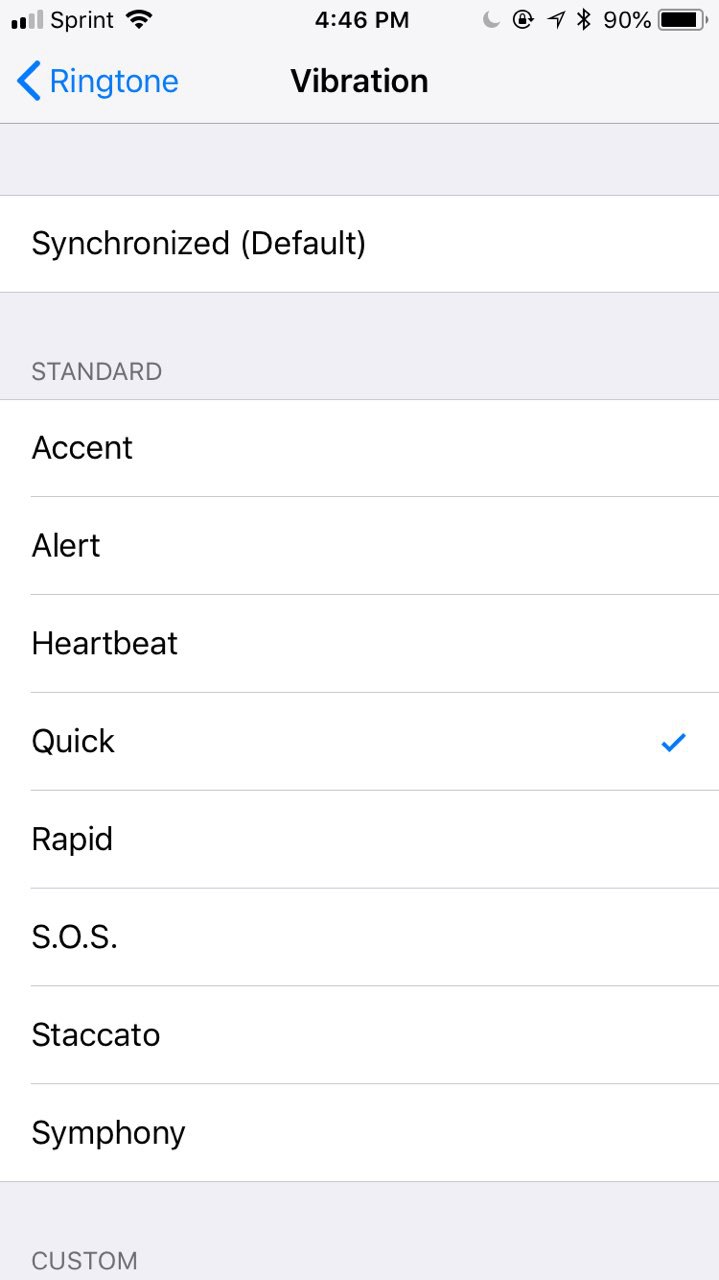
|
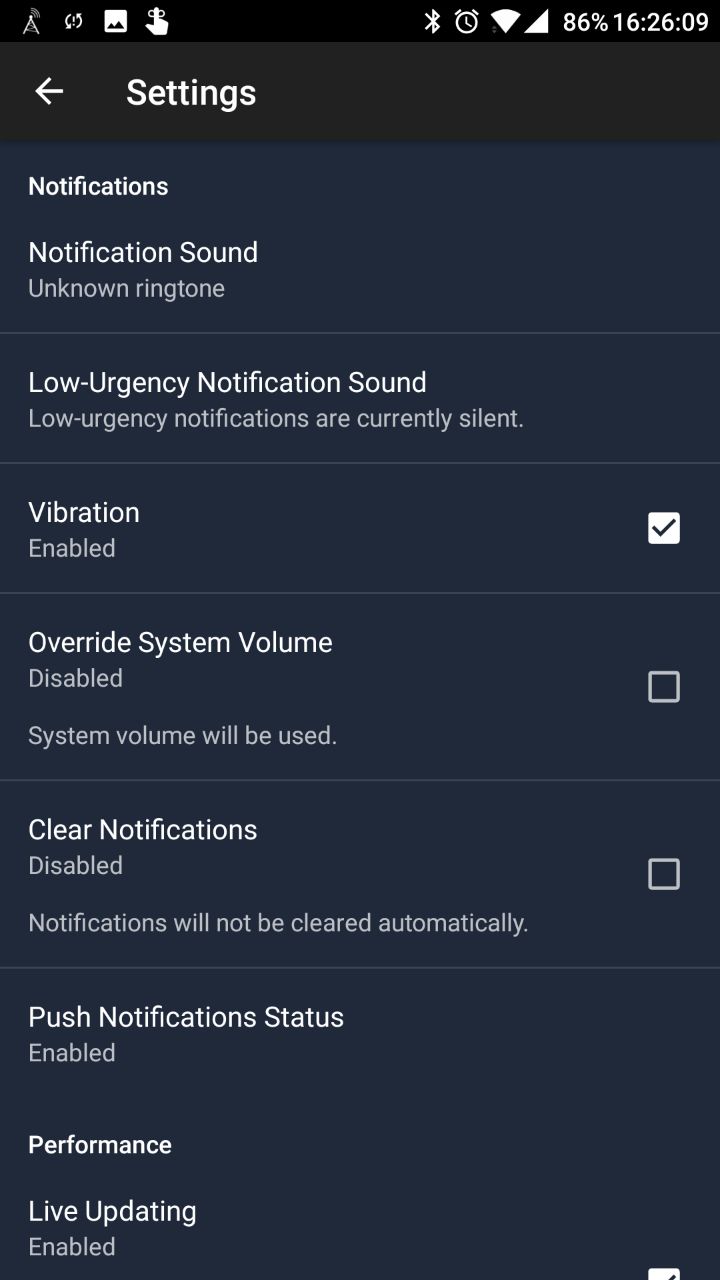
|
| Well golly gee! Look at them options! Who ever said iPhones were less customizable. I could have the rhythm of a ghostly symphony stirring against my leg and my phone could still be at the Apple Store. | Dare I sacrilege my duty to the servers? |
There are plenty of aural artifacts of modern, industrialized life that we have come to accept. The sound of a humming powerplant, an exhaling interstate, cars speeding around your bike, sirens in the night, unending piped music. Many of these don't carry the same emotional weight as a smartphone notification.
As our society moves into an always-on paradigm of globalization and technological integration, our ancestral genes are certainly going to get a bit fried. The senses of the previous generations are not the senses of our own. It's not a downright bad thing. But it's a trend that needs to be understood. As we plug electronics directly into our nervous systems, adjust our lifestyles, and place screens in our glasses, we should be aware of the psychological toll that each ping and pop has on our focus and mental capacity. You can do your own research on how bad context switching is for memory.
Occupations with stressful interactions with smartphones seem to have the strongest proclivity toward hallucinations of being paged. But the solution isn't to fight the pager. In technology there is a solution. With each issue resolution won after a nocturnal summoning, there is a way to make the system more resilient; to tune the alerts, to find a way to make peoples' lives easier through scheduling, training, or straight-up engineering. Keeping your employees and teammates sane is a damn important goal and I hope that one day it goes hand-in-hand with bringing up a 24/7 on-call rotation.
I'd love to learn more about your experiences with phantom vibrations. Or your knowledge of additional research on the topic. Please email me at [email protected] or fill out the survey!
...
- Did running this experiment trigger me?
- Yeah, kinda. At least I was expecting the buzz when I pushed the test button.
- Am I going to keep the OnePlus 3T?
- It's such a good phone aside from the buzzing :(. And the psychological conditioning does help me wake up in the middle of the night to deal with production fires. It also really encourages me to tune our alerts. My girlfriend might flush the phone down the toilet when I'm not looking, though.
- Have I looked into alternative ringtone apps/solutions?
- I probably should! But now that I've started researching this hallucination, I kind of think it's a neat way to track how much anxiety on-call and smartphones cause me. Improving that experience helps more than just me.
Wow this is just a blog, do I really need acknowledgements?
- Yvonne, for tolerating the buzz in the night and only hating me a little
- Sean, for being the most compassionate server overlord I could ask for
- Pie, for being super friendly and helpful in getting me to share my experiences as a young o11ycon-er
Two things have dramatically changed my conditioning in the past year
Firstly, I purchased a One Plus 7T, a phenomenal phone which no longer has this triggering vibration and additionally contains a number of improvements to the UI including easy access to greyscale mode!
Secondly, and probably more importantly, I joined Cloudflare where I am part of a follow-the-sun on-call rotation and have yet to be paged outside the hours of 9 to 5.
That being said, I can still recall the buzzing of my beloved One Plus 3T, but it has started to carry the feeling of gratitude for the situation I have entered and an empathy for all those who still experience this unsettling phenomenon.
- Drouin, Michelle, Kaiser, Daren H., & Miller Daniel A. (2012). Phantom vibrations among undergraduates: Prevalence and associated psychological characteristics. Computers in Human Behavior, 28, 1490–1496. Elsevier. PDF
- Goodman, Brenda. (2006).I Hear Ringing and There's No One There. I Wonder Why. New York Times. PDF
- Rothberg, Michael B. (2010). Phantom vibration syndrome among medical staff: a cross sectional survey. BMJ 2010;341:c6914. doi:10.1136/bmj.c6914 PDF
- Deb, Amrita. (2014). Phantom vibration and phantom ringing among mobile phone users: A systematic review of literature. Asia-Pacific Psychiatry, 7, 231-239. Wiley. PDF
- Chen, Chao-Pen, Wu, Chi-Cheng, Chang, Li-Ren, & Lin, Yu-Hsuan. (2014). Possible association between phantom vibration syndrome and occupational burnout. Neuropsychiatric Disease and Treatment, 10, 2307–2314. Dovepress. PDF
- Smith, Steven W. (1997). The Scientist and Engineer's Guide to Digital Signal Processing. p353. Califonia Technical Publishing. WEB PDF